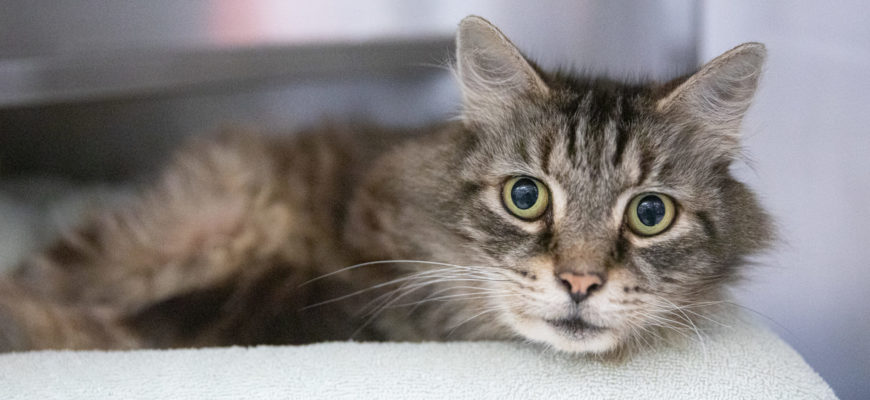It’s not uncommon to see some quirky or concerning behavior not long after bringing your newly adopted cat or kitten home. You’re all getting to know one another, and there can be bumps in the road as that happens. Here are some tips to work through the most common of those behaviors.
Cat not eating or using the litterbox
It’s very common for the stress of the move to a new home to cause a cat to stop eating for a short period of time. Along with that, you might see that the cat is not going to the bathroom at all. Make sure that your cat is comfortable in a safe acclimation room and that you’re offering a variety of both dry and wet foods (the stinkier, the better!) and that they have a large, clean, accessible litterbox without a cover in their safe space. Spend time in their room with them, talking to them, offering some great food motivators and you’ll see the cat begin to gain confidence, and with that, they’ll likely start to eat again, as well. Make sure that you check in with your veterinarian if your new cat goes too long without eating, though!
Cat hiding
It’s also very common for a cat to hide for a bit after moving to a new home, especially if they were nervous while in the shelter’s care, or have a history of being nervous in their previous home. Make sure that your new cat has a safe, comfortable acclimation room and allow them to hide. Spend time in the room, talking or reading aloud, offering really great food motivators, letting the cat know that you’re safe. With time and patience, your cat will come out to greet the world.
Cat or kitten “attacking” during play
Often, as you’re getting to know your new cat or kitten, they’ll seek playtime in a way that’s not at all how you’d like them to seek it. They may pounce on arms, legs or hands, seemingly out of nowhere and scratch or bite. It’s possible that you’ll move in to pet them and miss the subtle “play” signals they’re giving you and find yourself the victim of an attack. This is most often due to your cat simply not knowing how to interact appropriately with you, coupled with a bit of frustration and pent up energy. When you’re just getting to know one another, offering more playtime than affection time is going to be beneficial for both of you, especially if you’ve adopted a young cat or kitten who has energy to burn. Making sure that those play needs are met before you sit down on the couch to pet your new friend can really save you some bumps and bruises in the long term. Watch out for pupils dilating, tail swishing, hair coat standing up or twitching, ears twitching or any combination of these things as your cat may be saying “play with me” quite loudly as you reach in to pet them. Establishing a consistent routine of energetic play as often as possible, as well we offering really good environmental enrichment can help to ease some of these growing pains with a young or energetic cat.
Please see our handouts, “Rough Play in a Kitten or Adult Cat” and “Cat Toys for Fun and Enrichment” for more information.
Cat bites while being petted
Some cats just don’t like being petted for too long, and in a new relationship, you’re not going to know your cat well enough to know if this is the case. Especially in the beginning, keep pets to face, chin and cheeks and pay close attention to your cat’s body language as you do this. Some signs of overstimulated biting, or biting during petting, can be dilating pupils, tail swishing, hair coat standing up or twitching, sudden focus on your hand as you pet the cat, subtle freezing of all behaviors, body becoming tense or still, or a combination of these signs. If you see any of this body language, your cat is asking you to stop petting them, and it’s time to offer some treats, a long talk or redirect the cat away with a toy or a great food motivator. These cats often want to be close to their person, but don’t want pets, and it’s really about learning their body language and needs in order to have a truly great relationship.
Please see our handout, “Petting Related Aggression” for more information.
My cat is crying all night long!! Or, my cat is crying all day while I’m gone!
It’s very common for a cat to vocalize during times of stress, and moving to a new home can definitely trigger this behavior. It’s also important to remember that some cats are vocal by nature. Allowing your cat some time to settle in and find a routine can sometimes be all that’s needed to help this behavior. Making sure that your new cat has plenty of environmental enrichment, lots of attention and playtime when your are home and that her routine is as consistent as possible will really help to diminish the stress vocalizations and nighttime wake ups. Make sure that all of her resources (food, water and litterbox) are easy to find and that they’re not moving around too much, as well, as this can cause stress for any animal.
Please see our handouts, “Cat Toys for Fun and Enrichment”, “Cat Keeping You Up At Night?” and “Your Talkative Cat” for more information.
Litterbox problems
One of the biggest issues we see with a new adoption is that the cat is having accidents in their new home. Far more often than not, that issue is very easily resolved.
It’s very important that your cat have a safe space, an acclimation room, upon adoption that’s all theirs. Part of this acclimation time is to make sure that they’re comfortable with the type of litter and litterbox that they’ll be using in their new home. Offering one or more low, large, uncovered boxes to your new cat in that space, using clay or clumping litter only will be the best way to set them up for success.
Once the cat has free access to the home, they’ll need a low, large, uncovered box on every level of the home. For every cat in the home, you’ll need one litterbox per cat, plus one… so if you’ve got one cat, you’ll need at least two boxes in the home. It’s important that those boxes be easy to find and not hidden in scary places like the laundry room. Avoid using electronic litterboxes or alternative litter types with your new cat until they’ve had a chance to get used to those things as they’re likely not accustomed to them. You’ll be able to make the changes to the litterbox setup that you’d like to make eventually, but for now, until your cat is consistently using the boxes you’ve provided, keep those boxes plentiful, clean and easy to find and access.
If you find yourself with accidents happening, first make sure that you have provided enough boxes, that they’re easy for the cat to get in and out of and that both the box and the litter type are easily recognizable to the cat. Ask yourself if maybe the cat needed more time in their acclimation space… are they fearful and eliminating where they’re hiding in the home? Is it a kitten who can’t make it to the basement to use the litterbox? Is it an elderly cat who needs just one more litterbox to have enough access throughout the home? Perhaps they’ve met the resident dog or cat and need to move back through the introduction process to make everyone feel a bit more at ease?
Please see our handouts “Tips for Resolving Litterbox Problems” and “Your New Cat and the Litterbox” for more information.
Scratching objects
It’s not uncommon for a cat who is new to a home to scratch objects. It’s a way to mark their space, to shed the outer layer of their nails and to play and have fun. Initially offer your cat a variety of scratchers and observe which they seem most drawn to. Horizontal, vertical, a variety of surfaces… it’s also important that the scratcher be long enough for your cat to stretch out and scratch. Make sure that those scratchers are in places that the cat seems most interested in scratching. If you’re having issues making the post seem appealing, try using a variety of catnip and feeding some really great treats or wet food right there on/ near the scratcher can help to attract the cat to use it. Put something unappealing on the surface that they are scratching, something like double sided tape often works. There’s also a great product called Feliscratch that has worked wonders for some folks, it’s available at most pet stores. Also making sure that your cat’s nails are trimmed and that they have plenty of environmental enrichment can make a huge difference in their scratching behaviors.
Please see our handout “Managing Scratching” for more information.








